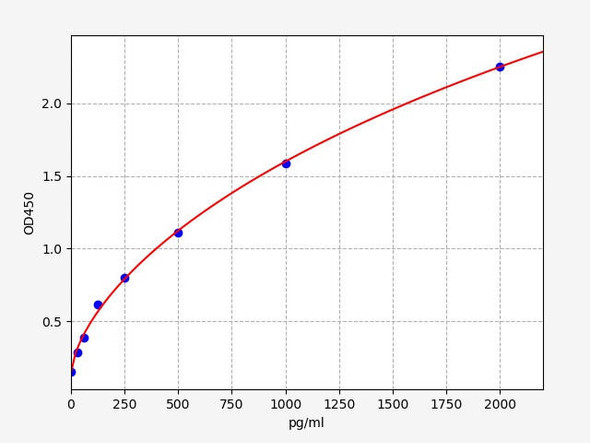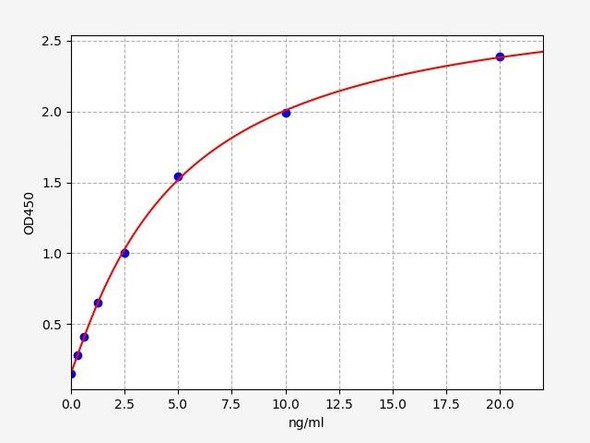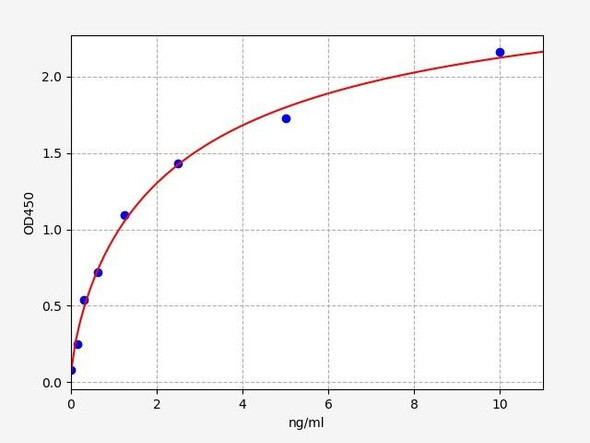Description
Human MFN2 (Mitofusin-2) ELISA Kit
The Human MFN2 (Mitofusin 2) ELISA Kit is specifically designed for the precise measurement of MFN2 levels in human samples such as serum, plasma, and cell culture supernatants. This kit is known for its exceptional sensitivity and specificity, ensuring accurate and consistent results that are suitable for various research applications.Mitofusin 2, a key protein involved in mitochondrial fusion and regulation of mitochondrial dynamics, plays a critical role in maintaining mitochondrial function and cell health.
Dysregulation of MFN2 has been linked to various diseases, including neurodegenerative disorders, metabolic syndromes, and cardiovascular conditions. This ELISA kit is an essential tool for investigating the role of MFN2 in these diseases and for developing potential therapeutic interventions.
| Product Name: | Human MFN2(Mitofusin-2) ELISA Kit |
| Product Code: | HUFI03036 |
| Size: | 96 Assays |
| Alias: | Mitofusin-2 |
| Detection method: | Sandwich ELISA, Double Antibody |
| Application: | This immunoassay kit allows for the in vitro quantitative determination of Human MFN2 concentrations in serum plasma and other biological fluids. |
| Sensitivity: | 18.75pg/ml |
| Range: | 31.25-2000pg/ml |
| Storage: | 4°C for 6 months |
| Note: | For Research Use Only |
| Recovery: | Matrices listed below were spiked with certain level of Human MFN2 and the recovery rates were calculated by comparing the measured value to the expected amount of Human MFN2 in samples. Enquire for more information. |
| Linearity: | The linearity of the kit was assayed by testing samples spiked with appropriate concentration of Human MFN2 and their serial dilutions. The results were demonstrated by the percentage of calculated concentration to the expected. Enquire for more information. |
| CV(%): | Intra-Assay: CV<8% Inter-Assay: CV<10% |
| Component | Quantity | Storage |
| ELISA Microplate (Dismountable) | 8×12 strips | 4°C for 6 months |
| Lyophilized Standard | 2 | 4°C/-20°C |
| Sample/Standard Dilution Buffer | 20ml | 4°C |
| Biotin-labeled Antibody(Concentrated) | 120ul | 4°C (Protect from light) |
| Antibody Dilution Buffer | 10ml | 4°C |
| HRP-Streptavidin Conjugate(SABC) | 120ul | 4°C (Protect from light) |
| SABC Dilution Buffer | 10ml | 4°C |
| TMB Substrate | 10ml | 4°C (Protect from light) |
| Stop Solution | 10ml | 4°C |
| Wash Buffer(25X) | 30ml | 4°C |
| Plate Sealer | 5 | - |
Other materials and equipment required:
- Microplate reader with 450 nm wavelength filter
- Multichannel Pipette, Pipette, microcentrifuge tubes and disposable pipette tips
- Incubator
- Deionized or distilled water
- Absorbent paper
- Buffer resevoir
| Uniprot | O95140 |
| UniProt Protein Function: | MFN2: Essential transmembrane GTPase, which mediates mitochondrial fusion. Fusion of mitochondria occurs in many cell types and constitutes an important step in mitochondria morphology, which is balanced between fusion and fission. MFN2 acts independently of the cytoskeleton. It therefore plays a central role in mitochondrial metabolism and may be associated with obesity and/or apoptosis processes. Overexpression induces the formation of mitochondrial networks. Plays an important role in the regulation of vascular smooth muscle cell proliferation. Defects in MFN2 are the cause of Charcot-Marie-Tooth disease type 2A2 (CMT2A2). CMT2A2 is a form of Charcot-Marie-Tooth disease, the most common inherited disorder of the peripheral nervous system. Charcot-Marie-Tooth disease is classified in two main groups on the basis of electrophysiologic properties and histopathology: primary peripheral demyelinating neuropathy or CMT1, and primary peripheral axonal neuropathy or CMT2. Neuropathies of the CMT2 group are characterized by signs of axonal regeneration in the absence of obvious myelin alterations, normal or slightly reduced nerve conduction velocities, and progressive distal muscle weakness and atrophy. Defects in MFN2 are the cause of Charcot-Marie-Tooth disease type 6 (CMT6); also referred to as autosomal dominant hereditary motor and sensory neuropathy VI (HMSN6). CMT6 is an autosomal dominant form of axonal CMT associated with optic atrophy. Belongs to the mitofusin family. 2 isoforms of the human protein are produced by alternative splicing. |
| UniProt Protein Details: | Protein type:Cell cycle regulation; Cytoskeletal; EC 3.6.5.-; Hydrolase; Membrane protein, integral; Membrane protein, multi-pass; Mitochondrial Chromosomal Location of Human Ortholog: 1p36.22 Cellular Component: cytosol; integral to membrane; intrinsic to mitochondrial outer membrane; mitochondrial outer membrane; mitochondrion Molecular Function:GTPase activity; protein binding; ubiquitin protein ligase binding Biological Process: blood coagulation; cell cycle arrest; macroautophagy; mitochondrial fusion; mitochondrial membrane organization and biogenesis; mitochondrion localization; negative regulation of Ras protein signal transduction; negative regulation of smooth muscle cell proliferation; protein targeting to mitochondrion Disease: Charcot-marie-tooth Disease, Axonal, Autosomal Recessive, Type 2a2b; Charcot-marie-tooth Disease, Axonal, Type 2a2; Neuropathy, Hereditary Motor And Sensory, Type Vi |
| NCBI Summary: | This gene encodes a mitochondrial membrane protein that participates in mitochondrial fusion and contributes to the maintenance and operation of the mitochondrial network. This protein is involved in the regulation of vascular smooth muscle cell proliferation, and it may play a role in the pathophysiology of obesity. Mutations in this gene cause Charcot-Marie-Tooth disease type 2A2, and hereditary motor and sensory neuropathy VI, which are both disorders of the peripheral nervous system. Defects in this gene have also been associated with early-onset stroke. Two transcript variants encoding the same protein have been identified. [provided by RefSeq, Jul 2008] |
| UniProt Code: | O95140 |
| NCBI GenInfo Identifier: | 47605777 |
| NCBI Gene ID: | 9927 |
| NCBI Accession: | O95140.3 |
| UniProt Secondary Accession: | O95140,O95572, Q5JXC3, Q5JXC4, Q9H131, Q9NSX8, A8K1B3 |
| UniProt Related Accession: | O95140 |
| Molecular Weight: | 86kDa |
| NCBI Full Name: | Mitofusin-2 |
| NCBI Synonym Full Names: | mitofusin 2 |
| NCBI Official Symbol: | MFN2 |
| NCBI Official Synonym Symbols: | HSG; MARF; CMT2A; CPRP1; CMT2A2; HMSN6A; CMT2A2A; CMT2A2B |
| NCBI Protein Information: | mitofusin-2 |
| UniProt Protein Name: | Mitofusin-2 |
| UniProt Synonym Protein Names: | Transmembrane GTPase MFN2 |
| Protein Family: | Mitofusin |
| UniProt Gene Name: | MFN2 |
*Note: Protocols are specific to each batch/lot. For the correct instructions please follow the protocol included in your kit.
Before adding to wells, equilibrate the SABC working solution and TMB substrate for at least 30 min at 37°C. When diluting samples and reagents, they must be mixed completely and evenly. It is recommended to plot a standard curve for each test.
| Step | Protocol |
| 1. | Set standard, test sample and control (zero) wells on the pre-coated plate respectively, and then, record their positions. It is recommended to measure each standard and sample in duplicate. Wash plate 2 times before adding standard, sample and control (zero) wells! |
| 2. | Aliquot 0.1ml standard solutions into the standard wells. |
| 3. | Add 0.1 ml of Sample / Standard dilution buffer into the control (zero) well. |
| 4. | Add 0.1 ml of properly diluted sample ( Human serum, plasma, tissue homogenates and other biological fluids.) into test sample wells. |
| 5. | Seal the plate with a cover and incubate at 37 °C for 90 min. |
| 6. | Remove the cover and discard the plate content, clap the plate on the absorbent filter papers or other absorbent material. Do NOT let the wells completely dry at any time. Wash plate X2. |
| 7. | Add 0.1 ml of Biotin- detection antibody working solution into the above wells (standard, test sample & zero wells). Add the solution at the bottom of each well without touching the side wall. |
| 8. | Seal the plate with a cover and incubate at 37°C for 60 min. |
| 9. | Remove the cover, and wash plate 3 times with Wash buffer. Let wash buffer rest in wells for 1 min between each wash. |
| 10. | Add 0.1 ml of SABC working solution into each well, cover the plate and incubate at 37°C for 30 min. |
| 11. | Remove the cover and wash plate 5 times with Wash buffer, and each time let the wash buffer stay in the wells for 1-2 min. |
| 12. | Add 90 µl of TMB substrate into each well, cover the plate and incubate at 37°C in dark within 10-20 min. (Note: This incubation time is for reference use only, the optimal time should be determined by end user.) And the shades of blue can be seen in the first 3-4 wells (with most concentrated standard solutions), the other wells show no obvious color. |
| 13. | Add 50 µl of Stop solution into each well and mix thoroughly. The color changes into yellow immediately. |
| 14. | Read the O.D. absorbance at 450 nm in a microplate reader immediately after adding the stop solution. |
When carrying out an ELISA assay it is important to prepare your samples in order to achieve the best possible results. Below we have a list of procedures for the preparation of samples for different sample types.
| Sample Type | Protocol |
| Serum | If using serum separator tubes, allow samples to clot for 30 minutes at room temperature. Centrifuge for 10 minutes at 1,000x g. Collect the serum fraction and assay promptly or aliquot and store the samples at -80°C. Avoid multiple freeze-thaw cycles. If serum separator tubes are not being used, allow samples to clot overnight at 2-8°C. Centrifuge for 10 minutes at 1,000x g. Remove serum and assay promptly or aliquot and store the samples at -80°C. Avoid multiple freeze-thaw cycles. |
| Plasma | Collect plasma using EDTA or heparin as an anticoagulant. Centrifuge samples at 4°C for 15 mins at 1000 × g within 30 mins of collection. Collect the plasma fraction and assay promptly or aliquot and store the samples at -80°C. Avoid multiple freeze-thaw cycles. Note: Over haemolysed samples are not suitable for use with this kit. |
| Urine & Cerebrospinal Fluid | Collect the urine (mid-stream) in a sterile container, centrifuge for 20 mins at 2000-3000 rpm. Remove supernatant and assay immediately. If any precipitation is detected, repeat the centrifugation step. A similar protocol can be used for cerebrospinal fluid. |
| Cell culture supernatant | Collect the cell culture media by pipette, followed by centrifugation at 4°C for 20 mins at 1500 rpm. Collect the clear supernatant and assay immediately. |
| Cell lysates | Solubilize cells in lysis buffer and allow to sit on ice for 30 minutes. Centrifuge tubes at 14,000 x g for 5 minutes to remove insoluble material. Aliquot the supernatant into a new tube and discard the remaining whole cell extract. Quantify total protein concentration using a total protein assay. Assay immediately or aliquot and store at ≤ -20 °C. |
| Tissue homogenates | The preparation of tissue homogenates will vary depending upon tissue type. Rinse tissue with 1X PBS to remove excess blood & homogenize in 20ml of 1X PBS (including protease inhibitors) and store overnight at ≤ -20°C. Two freeze-thaw cycles are required to break the cell membranes. To further disrupt the cell membranes you can sonicate the samples. Centrifuge homogenates for 5 mins at 5000xg. Remove the supernatant and assay immediately or aliquot and store at -20°C or -80°C. |
| Tissue lysates | Rinse tissue with PBS, cut into 1-2 mm pieces, and homogenize with a tissue homogenizer in PBS. Add an equal volume of RIPA buffer containing protease inhibitors and lyse tissues at room temperature for 30 minutes with gentle agitation. Centrifuge to remove debris. Quantify total protein concentration using a total protein assay. Assay immediately or aliquot and store at ≤ -20 °C. |
| Breast Milk | Collect milk samples and centrifuge at 10,000 x g for 60 min at 4°C. Aliquot the supernatant and assay. For long term use, store samples at -80°C. Minimize freeze/thaw cycles. |





